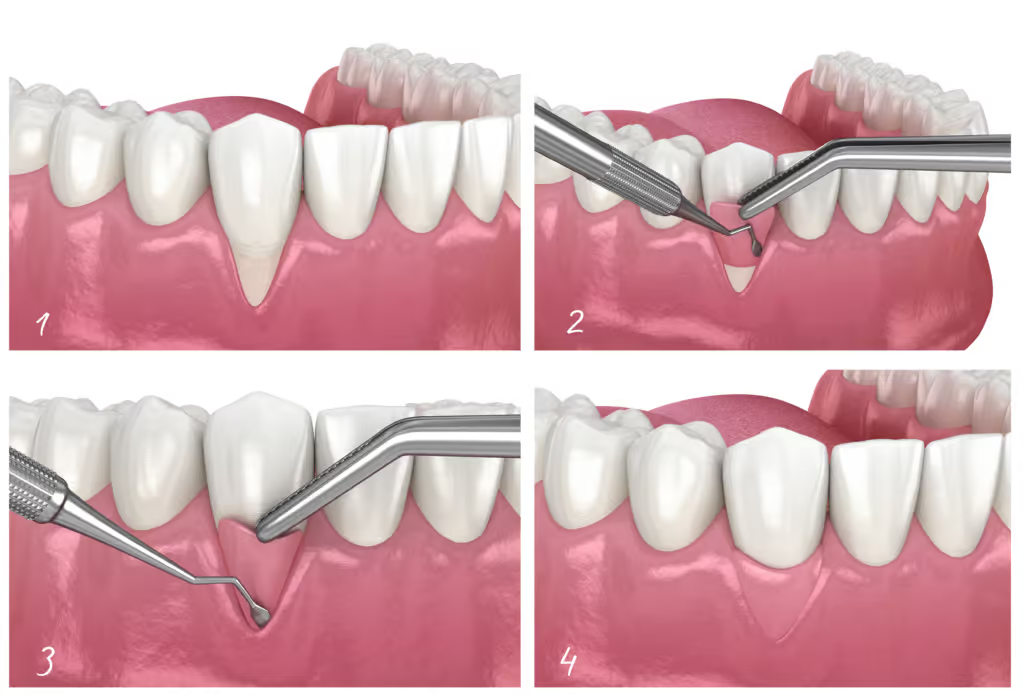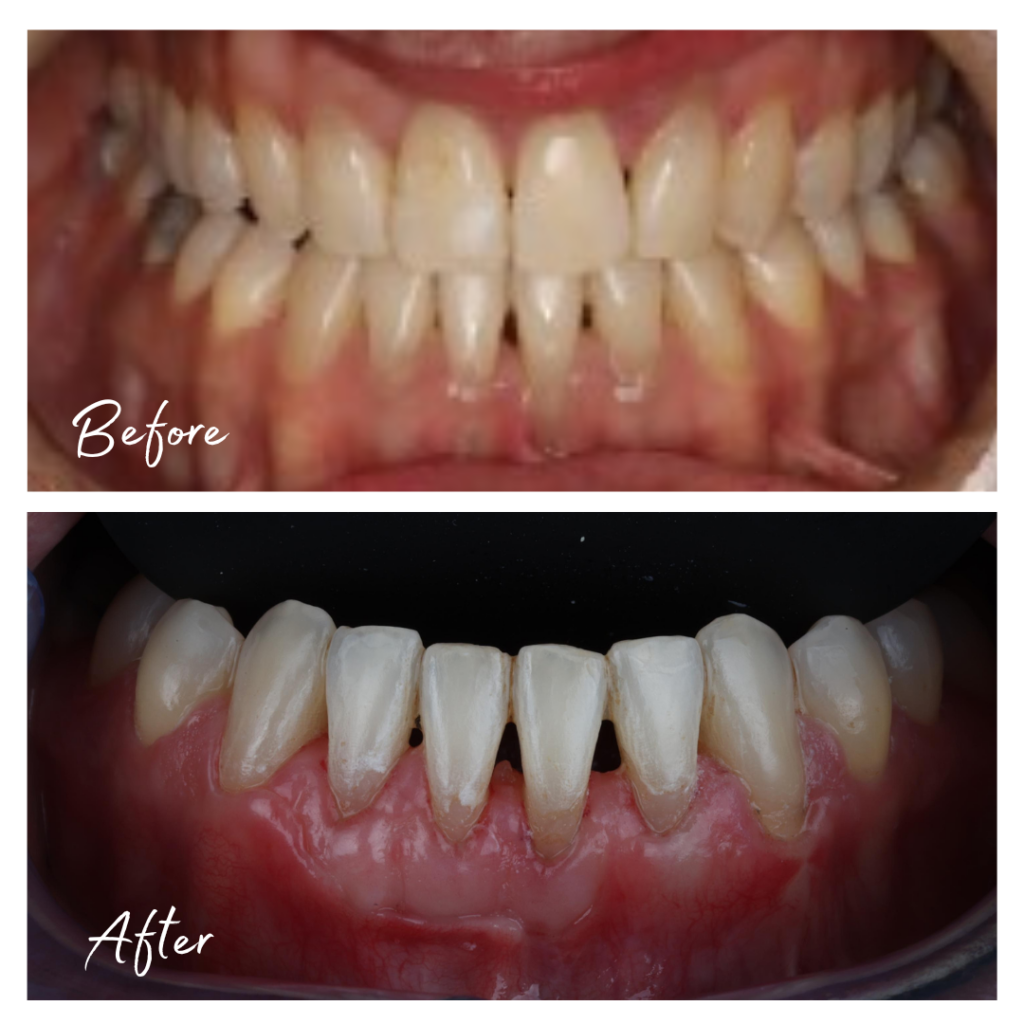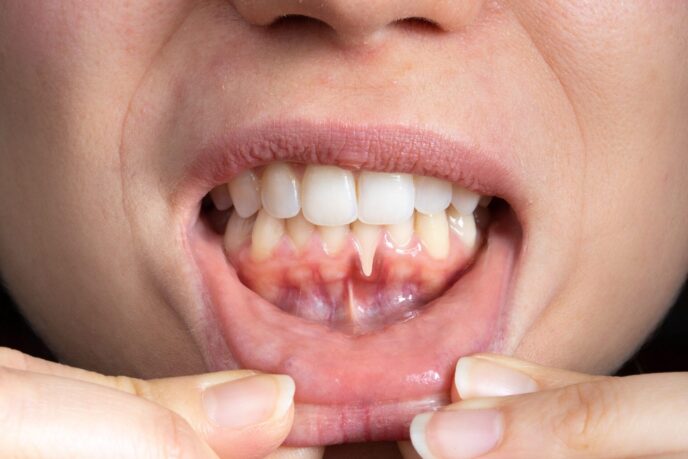Gum recession refers to the gradual exposure of the tooth roots due to the receding gum line. It occurs when the gum tissue surrounding the teeth pulls back, leading to the formation of gaps between the teeth and gums.
It can cause tooth sensitivity – particularly to temperatures and certain foods – increased vulnerability to decay, and a less aesthetically pleasing smile. Exposed tooth roots are more prone to cavities because they are softer and more porous than tooth enamel. If left untreated, it may lead to tooth loss and bone damage.
Common Causes of Gum Recession
Several factors contribute to gum recession, including poor oral hygiene, aggressive brushing, gum disease, and genetic predisposition.

One of the major causes of gum recession is regular aggressive tooth brushing, especially of teeth that have thin overlapping soft tissue and/or bone. Teeth that are either tipped or displaced towards either the lip or tongue can also lead to gum recession. This is due to the underlying bone (that’s needed to support the gum) being too thin to adequately support the overlying soft tissue.
The condition can also be caused by prolonged gingival inflammation (periodontal disease), which weakens the attachment between gum, bone, and teeth. Gingival recession can therefore be an underlying sign of gum disease. This is especially when present in combination with other clinical signs of periodontal disease, for example, tooth mobility. Periodontal disease is the leading cause of tooth loss, and it can be a contributing factor in heart disease and strokes.
If there is an insufficient amount of gingiva/gum around the necks of the teeth, gingival recession and bone loss can progress to the point where teeth are lost.
When do we treat gum recession?
Not all cases require treatment. Sometimes, the recession stabilises and the sensitivity may also resolve on its own, as there is sufficient gum tissue to protect the teeth.
Treatment of recession is normally reserved for:
- Where the recession is progressive (it doesn’t show signs of slowing down)
- Where it creates a cosmetic problem for patients, or when patients request treatment for aesthetic reasons, rather than functional.
- Where there is an insufficient amount of gum around the neck of a tooth to fully support and stabilize the teeth.
The aim of treatment is typically to prevent further recession, to improve the condition and volume of the gum in the area and, where possible, to cover the exposed root. Exposed teeth roots increase your risk of tooth decay, sensitivity and bone loss around teeth.
How do we treat Gum Recession?
Early detection and proper oral care, including gentle brushing, flossing, and regular dental check-ups, are crucial in preventing and managing gum recession. But if it does occur, there are ways to treat it.
When a case has been deemed legible for treatment, we begin by guiding the patient with their brushing technique and oral hygiene.
Aggressive brushing is a major cause of, and contributor to, gum recession. It is therefore important to assist patients with finding the balance between applying enough pressure to remove plaque and being gentle enough to prevent further recession.
Surgical Techniques – Gum Grafting

There are various surgical techniques that we employ to treat the problem. The biology of the site will determine the technique. In most instances, treatment involves the surgeon removing a small wedge of inner gum tissue from another area of the mouth (usually the palate). They then transplant it to the deficient site, to cover the exposed teeth roots (the area of recession). This is known as a gum graft.
Gum grafting replaces the lost tissue around your teeth and improves your overall oral health. The below case shows images of a patient of Dr Willie Ritz, specialist Periodontist at Enamel Clinic, before and after treatment.

Sometimes, in very specific instances, it may be possible to use substitute grafting material (a commercial product, which they can purchase from a licensed bone and tissue bank) instead of your own gum. In most instances, however, it is not the ideal option.
It is important to note that it is not always possible to cover an exposed root. There are certain biological factors that will determine whether an exposed root can be fully covered, partially covered, or not covered at all.
If you’re dealing with what looks like receding gums, contact the experts – our team of specialist periodontists – for advice on the best way forward.

